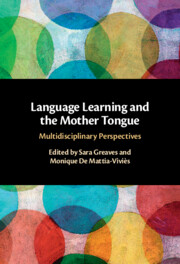Book contents
- Language Learning and the Mother Tongue
- Language Learning and the Mother Tongue
- Copyright page
- Epigraph
- Contents
- List of Contributors and Their Works
- Acknowledgements
- Introduction
- Part I The Mother Tongue and Second Language Learning
- Part II From the Mother Tongue to the Second Mother Tongue
- Part III The Second Mother Tongue as a (M)other Tongue and the Return to the Body
- 7 The Sea of Language
- 8 Samuel Beckett’s Change of Literary Language
- 9 Language, the Brain, and Relating
- Subject Index
- Author Index
- References
9 - Language, the Brain, and Relating
from Part III - The Second Mother Tongue as a (M)other Tongue and the Return to the Body
Published online by Cambridge University Press: 16 June 2022
- Language Learning and the Mother Tongue
- Language Learning and the Mother Tongue
- Copyright page
- Epigraph
- Contents
- List of Contributors and Their Works
- Acknowledgements
- Introduction
- Part I The Mother Tongue and Second Language Learning
- Part II From the Mother Tongue to the Second Mother Tongue
- Part III The Second Mother Tongue as a (M)other Tongue and the Return to the Body
- 7 The Sea of Language
- 8 Samuel Beckett’s Change of Literary Language
- 9 Language, the Brain, and Relating
- Subject Index
- Author Index
- References
Summary
In this chapter, the author, from the double perspective of ethology and neuropsychiatry, gives an interdisciplinary account of language through the lens of the neurosciences, interweaving diverse scientific discourses. Using phylogenetic and ontogenetic accounts, he describes the transition from sensory perception to symbolic representation in animals and humans, and the way neural circuitry of language coalesces through relating. He thus maps the processes and trajectories of the ‘word-making machine’, corroborated by studies of sensory or institutional deprivation or of illness, abuse, or accidents. Studies carried out on plurilingual speakers recovering from aphasia reveal that the Mother tongue, the most deeply imprinted language, is the one that comes back first. Experiments with newborn babies confirm the origin of the Mother tongue in tactile interuterine stimuli, which are later recognised by the newborn in the lower frequencies of the mother’s voice, creating ‘a reassuring bond of familiarity’. This interdisciplinary approach sheds light on the embedding of language in the body and on the enduring imprint of early language formation in the brain.
Keywords
- Type
- Chapter
- Information
- Language Learning and the Mother TongueMultidisciplinary Perspectives, pp. 171 - 186Publisher: Cambridge University PressPrint publication year: 2022

